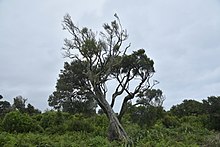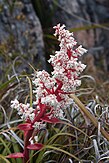User:Dracophyllum/Dracophyllum
| Dracophyllum/Dracophyllum | |
|---|---|
| Clockwise from top: D. arboreum, D. milliganii, D. traversii, D. muscoides | |
| Scientific classification | |
| Kingdom: | Plantae |
| Clade: | Tracheophytes |
| Clade: | Angiosperms |
| Clade: | Eudicots |
| Clade: | Asterids |
| Order: | Ericales |
| Family: | Ericaceae |
| Subfamily: | Epacridoideae |
| Tribe: | Richeeae |
| Genus: | Dracophyllum Labill. |

| |
Range
| |
Dracophyllum is a genus of plants belonging to the family Ericaceae, formerly Epacridaceae. There are 61 species in the genus, mostly shrubs, but also cushion plants and trees, found in New Zealand, Australia, Lord Howe Island and New Caledonia.[1] The name Dracophyllum, meaning dragon-leaf, refers to their strong similarity to the unrelated Dracaena, sometimes known as dragon tree. Although dicotyledonous, they resemble primitive monocots with their slender leaves concentrated in clumps at the ends of the branches; they are sometimes called grass-trees. Their height varies from one centimetre (D. minimum) to about 12 metres (D. longifolium).
The genus was first collected by science by J.R. Forster in New Zealand, 1773. Originally called Epacris, Dracophyllum was...
Description[edit]
Plants in the genus Dracophyllum vary greatly in their morphology, from 5 mm cushion plants to trees more than 13 m tall, [2] though all generally have the following characteristics. Dracophyllum leaves are either bunched at the end of the branches, spiralled around an axis, or overlapping one another. Some species have distinctive juvenile leaves, which are typically wider and longer than their adult counterparts, and are leathery, with a straight to triangular shape. They may be hairless, covered in many soft or rigid hairs, or wrinkled.[3]
Adult leaves, however, have shoulders that taper to a point
Lorem ipsum dolor sit amet, consectetur adipiscing elit. Donec eget vehicula erat. Nunc in euismod felis. Etiam tempor libero in efficitur ultrices. Ut mattis quam pharetra augue iaculis, vel porttitor odio fringilla. Praesent ut cursus nibh, vitae hendrerit risus. Pellentesque finibus mi ac faucibus rhoncus. Etiam sed vulputate diam. Integer risus arcu, commodo in lacus eget, viverra imperdiet arcu. Vivamus efficitur rutrum risus eget scelerisque.Lorem ipsum dolor sit amet, consectetur adipiscing elit. Donec eget vehicula erat. Nunc in euismod felis. Etiam tempor libero in efficitur ultrices. Ut mattis quam pharetra augue iaculis, vel porttitor odio fringilla. Praesent ut cursus nibh, vitae hendrerit risus. Pellentesque finibus mi ac faucibus rhoncus. Etiam sed vulputate diam. Integer risus arcu, commodo in lacus eget, viverra imperdiet arcu. Vivamus efficitur rutrum risus eget scelerisque.Lorem ipsum dolor sit amet, consectetur adipiscing elit. Donec eget vehicula erat. Nunc in euismod felis. Etiam tempor libero in efficitur ultrices. Ut mattis quam pharetra augue iaculis, vel porttitor odio fringilla. Praesent ut cursus nibh, vitae hendrerit risus. Pellentesque finibus mi ac faucibus rhoncus. Etiam sed vulputate diam. Integer risus arcu, commodo in lacus eget, viverra imperdiet arcu. Vivamus efficitur rutrum risus eget scelerisque.Lorem ipsum dolor sit amet, consectetur adipi
scing elit. Donec eget vehicula erat. Nunc in euismod felis. Etiam tempor libero in efficitur ultrices. Ut mattis quam pharetra augue iaculis, vel porttitor odio fringilla. Praesent ut cursus nibh, vitae hendrerit risus. Pellentesque finibus mi ac faucibus rhoncus. Etiam sed vulputate diam. Integer risus arcu, commodo in lacus eget, viverra imperdiet arcu. Vivamus efficitur rutrum risus eget scelerisque.Lorem ipsum dolor sit amet, consectetur adipiscing elit. Donec eget vehicula erat. Nunc in euismod felis. Etiam tempor libero in efficitur ultrices. Ut mattis quam pharetra augue iaculis, vel porttitor odio fringilla. Praesent ut cursus nibh, vitae hendrerit risus. Pellentesque finibus mi ac faucibus rhoncus. Etiam sed vulputate diam. Integer risus arcu, commodo in lacus eget, viverra imperdiet arcu. Vivamus efficitur rutrum risus eget scelerisque.Lorem
ipsum dolor sit amet, consectetur adipiscing elit. Donec eget vehicula erat. Nunc in euismod felis. Etiam tempor libero in efficitur ultrices. Ut mattis quam pharetra augue iaculis, vel porttitor odio fringilla. Praesent ut cursus nibh, vitae hendrerit risus. Pellentesque finibus mi ac faucibus rhoncus. Etiam sed vulputate diam. Integer risus arcu, commodo in lacus eget, viverra imperdiet arcu. Vivamus efficitur rutrum risus eget scelerisque.Lorem ipsum dolor sit amet, consectetur adipiscing elit. Donec eget vehicula erat. Nunc in euismod felis. Etiam tempor libero in efficitur ultrices. Ut mattis quam pharetra augue iaculis, vel porttitor odio fringilla. Praesent ut cursus nibh, vitae hendrerit risus. Pellentesque finibus mi ac faucibus rhoncus. Etiam sed vulputate diam. Integer risus arcu, commodo in lacus eget, viverra imperdiet arcu. Vivamus efficitur rutrum risus eget scelerisque.Lorem ipsum dolor sit amet, consectetur adipiscing elit. Donec eget vehicula erat. Nunc in euismod felis. Etiam tempor libero in efficitur ultrices. Ut mat
tis quam pharetra augue iaculis, vel porttitor odio fringilla. Praesent ut cursus nibh, vitae hendrerit risus. Pellentesque finibus mi ac faucibus rhoncus. Etiam sed vulputate diam. Integer risus arcu, commodo in lacus eget, viverra imperdiet arcu. Vivamus efficitur rutrum risus eget scelerisque.
Taxonomy[edit]
|
Dracophyllum is a genus in the family Ericaceae published by Labill in Voy. 2: 210. T. 40 (1798), with 61 species and 2 varieties.[4]
History[edit]
The first two specimens of the genus Dracophyllum were collected by J.R. Forster and his son J. G. A. Forster in March 1773 in Fiordland, New Zealand and described as two different species Epacris longifolia (Dracophyllum longifolium) and Epacris rosmarinifolia (Dracophyllum rosmarinifolium). Now the genus Epacris is used to describe an endemic Australian genus of 40 species other than the one published by the Forsters.[5]
In 1800, the genus name Dracophyllum was used for the first time by Jaques Labillardière to describe a plant specimen collected in New Caledonia. Ten years after the first Dracophyllum species was published, Robert Brown divided the genus into two subgenera: Dracophyllum and Sphenotoma based on some distinct morphological traits of corolla, stamens, bracts, and inflorescence. The first full description of the genus Dracophyllum was published by De Candolle in 1838 and was included in the family Epacrideae. In 1844, Hooker gave the first full descriptions of the species and the species relationships, mentioning that Sphenotoma had been raised to genus level by Sweet in 1827. A century later, Dracophyllum (as Eudracophyllum), Oreothamnus had been raised to subgenus level and Cordophyllum was described as a third subgenus by Oliver in 1928. Sphenotoma was removed from the genus.[5] Following numerous studies which focused on the genetic relationships of Dracophyllum, Stephanus Venter revised the genus in 2021, removing Subg. Sphenotoma and instead keeping Subg. Oreothamnus (29 spp.) and Subg. Dracophyllum (21 spp.), as well as two new subgenera,
Phylogeny[edit]
Dracophyllum has been found closely related to Richea and Sphenotoma, which are two genera endemic to south-eastern Australia and south-western Australia respectively. The three genera form a prominent clade in the strict consensus tree based on a molecular analysis by Crayn et al. in 1998. Traditionally, Dracophyllum is divided into three subgenera: subgenus Dracophyllum with 20 species found across New Zealand, Australia, Tasmania, Lord Howe Island, and New Caledonia; subgenus Cordophyllum with one species in New Caledonia; and subgenus Oreothamnus with 29 species in New Zealand and Tasmania.[5]
The largest genetic study was published in 2010, sequencing the plastid data of 36 of the species in the genus Dracophyllum and 10 in the former genus Richea, and combining rbcL and matK genes from the GenBank. Though they only sequenced 45 of the 61 species in the genus (74%), the species were chosen so as to represent the maximum morphological diversity found in the genus. The cladogram they produced is shown at right.[6]
Distribution and habitat[edit]
Dracophyllum species are spread throughout Australasia, in Australia, Tasmania, Lord Howe Island, New Caledonia, and New Zealand. In Australia they can be found in on the east coast of the mainland as well as Tasmania. In New Caledonia they occur on both the mainland and on the Isle of Pines, while in New Zealand they grow naturally on the North (Te Ika-a-Māui), South (Te Waipounamu), Chatham (Rekohu), Pitt (Rangiaotea), Campbell (Motu Ihupuku), Auckland (Maungahuka), Great barrier (Aotea) and Little Barrier (Hauturu) Islands.[3][6]
Evolution and biogeography[edit]
The largest of the molecular studies on the genus, published in 2010, found that Dracophyllum and the former genus Richea diverged from the closely related Sphenotoma around 16 million years ago. Two sets of long distance dispersal from Australia 5.6 and 6.2 million years ago led to the radiation of the genus out to New Zealand and New Caledonia, though an earlier Richea fossil in New Zealand points to an even earlier lineage that has since gone extinct. The greatest genetic diversity is found among species in Australia, as a result of their older heritage, while the most morphological diversity is found in New Zealand and New Caledonia. Cushion plants such as D. muscoides, for example, have evolved alongside large trees such as D. traversii.[3][6]
Ecology[edit]
Hybrids[edit]
There are no known hybrids in the subg. Dracophyllum, though one has been identified in subg. Richea: × R. curtisiae A.M.Gray, though there are many in Subg. Oreothamnus...[3]
In culture[edit]
Gallery[edit]
- Dracophyllum
References[edit]
- ^ Eagle, Audrey (2006). Eagle's complete trees and shrubs of New Zealand. New Zealand: Te Papa Press. p. 564. ISBN 0-909010-08-0.
- ^ Venter 2021, pp. 7–8.
- ^ a b c d Cite error: The named reference
:1was invoked but never defined (see the help page). - ^ "Dracophyllum Labill". COL. Retrieved 2021-02-18.
{{cite web}}: CS1 maint: url-status (link) - ^ a b c Venter, Stephanus (2009). "A Taxonomic Revision of the Genus Dracophyllum Labill. (Ericaceae)".
{{cite journal}}: Cite journal requires|journal=(help) - ^ a b c Wagstaff, Steven J.; Dawson, Murray I.; Venter, Stephanus; Munzinger, Jérôme; Crayn, Darren M.; steane, Dorothy A; Lemson, Kristina L. (2010). "Origin, Diversification, And Classification Of The Australasian Genus Dracophyllum (Richeeae, Ericaceae) 1". Annals of the Missouri Botanical Garden. 97 (2): 235–258. ISSN 0026-6493.
Bibliography[edit]
Journals[edit]
- Venter, Stephanus (March 2021). "A taxonomic revision of the Australasian genera Dracophyllum and Richea (Richeeae: Styphelioideae: Ericaceae)". Australian Systematic Botany. 34 (2). doi:10.1071/SB19049_CO. ISSN 1030-1887.
Websites[edit]
- de Lange, Peter (2012). "Dracophyllum fiordense". New Zealand Plant Conservation Network. Retrieved 2021-01-30.
{{cite web}}: CS1 maint: url-status (link)










